Our travel journal tries to capture the essence of an authentic Vietnamese adventure, rich in cultural immersion and natural wonders.
You can draw your inspiration from this circuit quite close to ours, proposed by Mr Linh’s Adventures.
We wish you to experience such beautiful and intense emotions! Pierre & Lea
Day 1: Hanoi - Nghia Lo, first immersion
The van pulled away from the chaos of Hanoi this morning.
Honestly, I was a bit nervous, more accustomed to screens than to rice paddies. But two hours later, we arrived in Duong Lam.
As part of the Asia-Pacific cultural heritage conservation awards, this ancient village received the UNESCO Award of Merit. But it wasn't this somewhat pompous title that immediately fascinated Pierre; rather, it was the houses, 100 to 400 years old, the laterite walls, and a thousand-year-old banyan tree. I could already see him sketching his future drawings. The atmosphere was incredibly calm compared to the city.
Then Mia Pagoda... Even I, the chatterbox, shut my mouth there. Nearly 300 15th-century wooden statues! It exuded an incredible serenity. Pierre put his hand on my shoulder, and I knew we were connected, silently.
After a homemade lunch, the road unfolded flat rice paddies, then high-altitude tea plantations, and finally, corn amidst gigantic karst rocks. Nature began to speak to us, and we listened, fascinated.
We ended the day in Nghia Lo, at a White Thai family's stilt house. The sun was setting; I can't wait to see Pierre's drawings!
Day 2: Nghia Lo–Mu Cang Chai: a sensory awakening amid terraced splendor
The rooster's crow signaled wake-up this morning in Nghia Lo. Sleeping at a White Thai stilt house is a unique experience; no blaring alarm, just nature calling.
After a good,
typical Thai breakfast, we left for a bike ride. Léa narrowly avoided a chicken and told me, "The traffic is less dense than in Hanoi, huh?" I laughed. We rode calmly amidst rice paddies and cornfields, passing ducks, chickens, pigs, and water buffalo that watched us with a jaded air. To myself, silently, I whispered, "This is real life, Léa. No screens, just the rhythm of the earth." Léa loved this outdoor break, facing the green fields.
The
road to Mu Cang Chai was both a challenge and a wonder. The
Khau Pha Pass offered stunning views, each turn revealing a new tableau. The
rice paddies of Tu Le were simply magnificent. It's the kind of landscape you try to capture with a lens, but which mostly imprints itself on your memory. In
Nam Co, the costumes of the
Flower H'mong were incredibly intricate, with patterns that invited drawing. Léa was delighted, fascinated by these colors. But the highlight of the day was undoubtedly the terraced
rice fields of Mam Soi in La Pan Tan. After a short walk, we reached a viewpoint that left us speechless. Waves of terraces sculpted the mountains as far as the eye could see. Pierre tried to take some shots, but he knows that drawings will better convey this feeling of immensity and the perfection of the lines. For once, I was speechless, eyes shining.
A day rich in visual inspirations and emotions, before spending the night at Madame Chon's, another
White Thai family in Kim Noi.
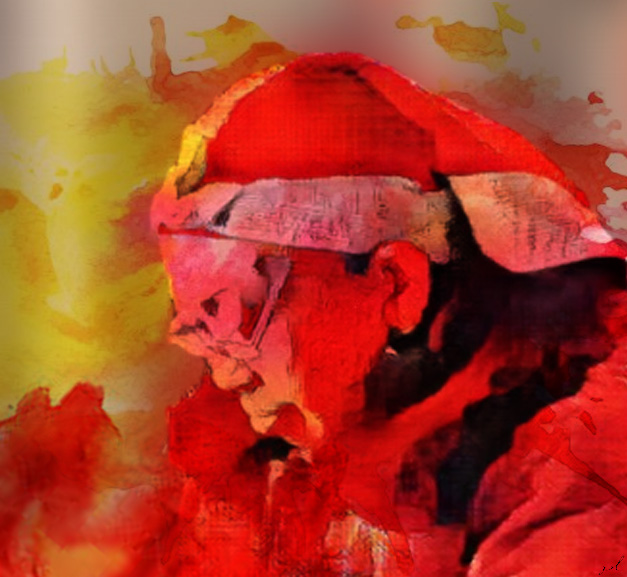 Portrait of a Red Dao woman - Mixed media on Arches ragpaper
Portrait of a Red Dao woman - Mixed media on Arches ragpaper Day 3: Mu Cang Chai to Sapa: peak thrills and Dao encounters
After our night at Madame Chon's, the wake-up was gentle but the excitement palpable: direction Sapa!
Pierre had already checked the itinerary and its famous switchbacks. He told me, smiling, "Hold on, Léa!" but frankly, I didn't even get sick! The road was absolutely insane; each turn opened onto a new panorama, a raw green immensity. Even my playlist stayed at the bottom of my bag, as I was glued to the windshield. Frankly,
the Sin Ho Pass is something else! You really feel above the world. Pierre was bustling with his camera; he was in seventh heaven. It's the kind of landscape he'll try to reproduce in sketches to capture that feeling of vertigo and infinity.
We arrived in
Sapa in the late morning. The town has a bit of a mountain resort feel, with its mysterious fog. After lunch, Pierre looked for the perfect angle for his photos of the town while I browsed the craft stalls. In the afternoon, we embarked on the
trek to Giang Ta Chai village. My calves suffered a bit, but the landscapes through the rice paddies and bamboo forests were really worth it. Pierre observed how the rice fields hugged the terrain, the different shades of green. In the evening, we
had dinner and slept in a Dao house, and I loved exchanging smiles with the children. Pierre, meanwhile, spent time observing the traditional architecture. A total immersion!
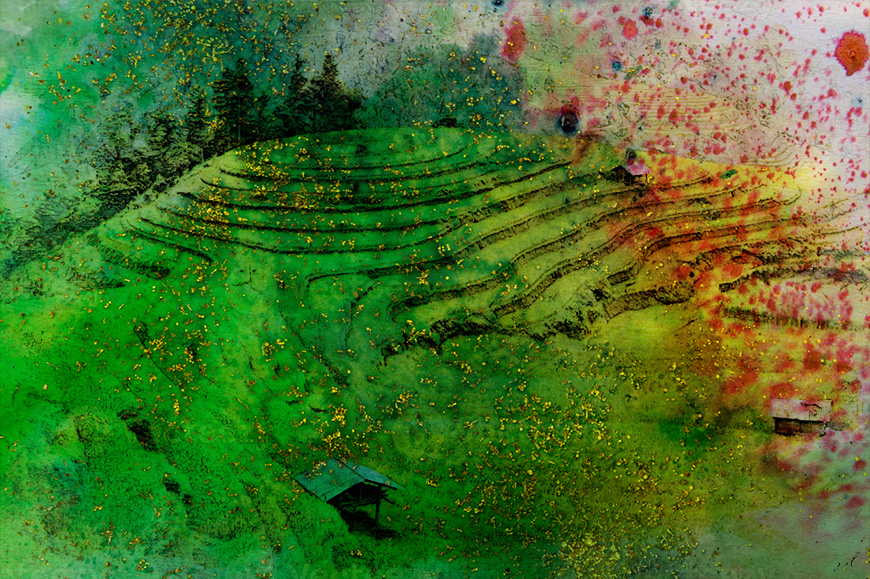 Hoang Su Phi Rice Terrace Fields - Mixed media on Arches ragpaper
Hoang Su Phi Rice Terrace Fields - Mixed media on Arches ragpaper Day 4: Bac Ha market and the call of Hoang Su Phi terraces
The sun rose over Giang Ta Chai, and after a peaceful night with the Dao, we headed for Bac Ha.
Léa was super excited, especially since today was
Sunday, so
market day! Upon arrival, it was a real "multicolored hive," a fireworks display of colors. Léa loved trying to guess where people came from just by their costumes. "Look, Pierre, the Flower H'mong and their incredible skirts! And over there, Dao, for sure!" It was a true joyful cacophony, with animals braying at the livestock market. I, of course, was already in paparazzi mode with my camera. It was a feast for the eyes and ears, a total immersion in local life.
After lunch, we visited the
Hoang A Tuong palace. What immediately struck me was the curious mix of styles, Baroque and Oriental. It was like stepping back in time. Then, we took a small mountain road, and there, the spectacle! Rice terraces as far as the eye could see, villages perched everywhere. This is the kind of landscape I'll try to reproduce in wash drawings; I'd like to capture and convey that feeling of immensity.
We arrived at
Ban Phung village, and Léa observed the
La Chi women, with their black skirts and delicate embroideries. They sometimes carry heavy loads on their foreheads, which makes you reflect on the hardship of their daily lives. The day ended in
Hoang Su Phi, where a hotel awaited us. A good night's rest after so many emotions.
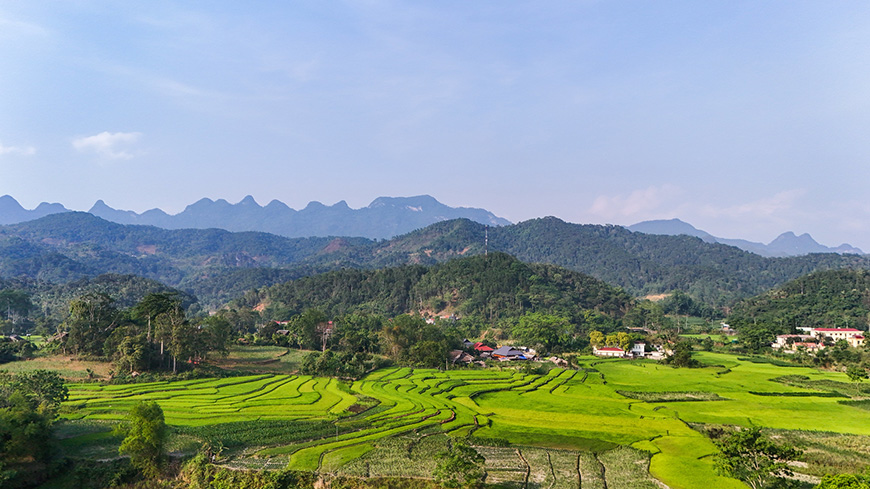 Landscapes of Ha Giang - Sony A7R III
Landscapes of Ha Giang - Sony A7R IIIDay 5: Hoang Su Phi: terraces’ zenith en route to Ha Giang
Waking up in Hoang Su Phi was incredibly gentle. We are truly "off the beaten path" here, and I love that! Pierre, his eyes already fixed on the landscape, murmured that it was "another dimension". And he was right! The
terraced rice fields here don't just hug the hills, they sublimate them, like infinite waves. I was simply amazed by the shades of green and the morning light playing with the reflections. Magnificent
tea plantations, some centuries old, added a touch of dense and organized greenery to this already perfect picture. The fresh scent of leaves floated in the air.
Then, the road to Ha Giang was an opportunity to cross the
Tan Su Phin Pass. These passages are incredibly spectacular. Each turn revealed a new panorama, a new immensity, and photo opportunities were countless. Pierre was thrilled, his camera never leaving him. As for me, I had put away my phone, preferring to visually immerse myself in each horizon. This is the kind of landscape that humbles you and reconnects you to the essential.
The day concluded with our arrival in Ha Giang and another night in a Tay family's stilt house.
 Ma Pi Leng Pass - Mixed media on Arches ragpaper
Ma Pi Leng Pass - Mixed media on Arches ragpaper Day 6: Karst Plateau heart: Dong Van & vertiginous Ma Pi Leng
After a night at the Tay family's, we hit the road this morning. Destination
Dong Van, and we crossed the
Cong Troi Pass – the "Heaven's Gate" – and its name did not lie! Léa was glued to the window, telling me: "Pierre, look at that! It's crazy how small we feel here!" The mountains rose majestically. Along the way, we stopped at the
H'mong King's Palace in
Sa Phin H'mong village. I was totally absorbed, fascinated by the history. Léa, meanwhile, imagined life back then in this impressive building. It was also surprising to see all these corn plantations, where harvesting is still done by hand. Incredible work!
The arrival in Dong Van changed the atmosphere. We had lunch in the colorful market of
the old quarter, a true visual festival with its old stone houses and inhabitants in traditional costumes. Pierre was trying to photograph everything, while I spontaneously smiled at everyone. But the highlight of the show was after lunch: the
Ma Pi Leng Pass! The road is just incredible, "one of the most beautiful in the country," as they say in the guides. Cliffs plunging steeply into the
Nho Que River; it was dizzying. I remained silent (yes, it happened to me several times, I'll have to consult!), just admiring, while Pierre was almost overexcited, trying to immortalize these stunning gorges.
Once we arrived in
Meo Vac, fatigue was present, but a happy fatigue, that of having witnessed unforgettable panoramas.
 On the road to Meo vac - Sony A7R III
On the road to Meo vac - Sony A7R IIIDay 7: The simpliciyty of Meo Vac and Nung craftsmanship
Meo Vac woke us this morning with its peaceful atmosphere, typical of small mountain towns. It's a melting pot of cultures, home to the Tay, Dao, H'mong, and Lo Lo ethnic groups.
Speaking of the Lo Lo, we took advantage of our stop in Meo Vac to make a detour to the
village of Sang A Pa, where the culture and traditions of this fascinating people are still honored. A complete change of scenery in a setting that is both spectacular and relaxing.
After soaking up the sights and sounds, we headed towards
Bao Lac for lunch, stopping in a few villages. The road was still very mountainous, but the views were starting to become familiar. Our last stop was the
Nung village of Pac Rang. It is known for its blacksmiths and their agricultural tools. Léa was fascinated by the heat of the forges and the dexterity of the hands. I observed these artisans for a long time, masters of ancestral know-how, reflecting on the contrast with our ultra-technological societies.
The day ended with dinner and a night at a
Nung family's home. We truly feel privileged to experience this, far from our connected world.
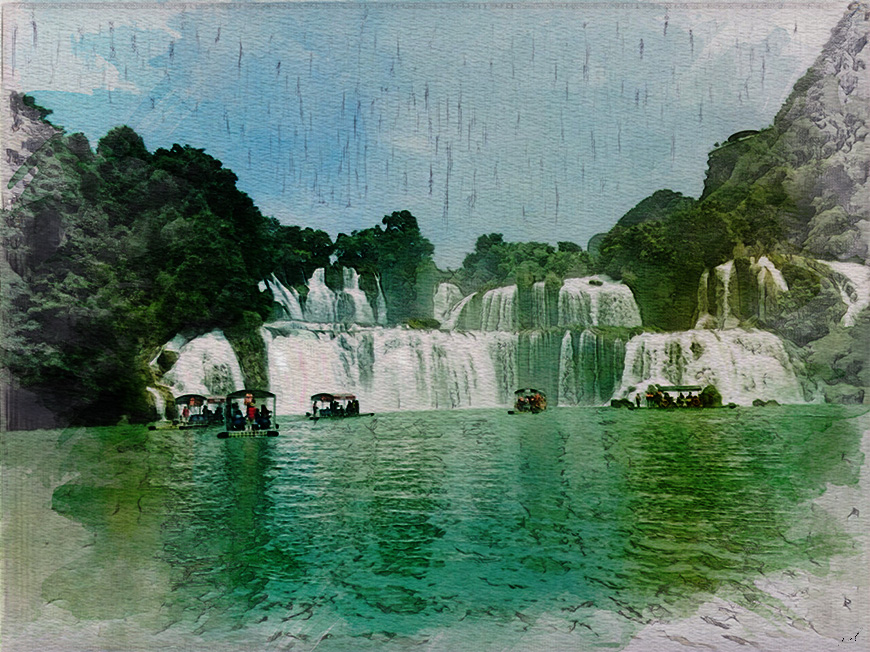 Ban Gioc Waterfalls - Mixed media on Arches ragpaper
Ban Gioc Waterfalls - Mixed media on Arches ragpaper Day 8: Ban Gioc waterfalls and the magic of Ba Be lake
After a comfortable night with our Nung hosts, we hit the road from
Cao Bang this morning. The destination of the day was legendary:
Ban Gioc waterfalls. We had seen photos of them everywhere in Hanoi, but there, in real life, it was just incredible! The roar of the water grew louder as we approached. It's also the border with China, so we were literally on the edge of two countries. The water cascaded down in several tiers; it was a magnificent spectacle, with the mist and rainbows. While the falls are iconic, the reality exceeded all our expectations.
After the falls, we went to explore
Nguom Ngao cave, the "Tiger Cave". As soon as we entered, Léa shouted "Wow! It's immense!" And it was true! The limestone formations, the stalactites of all shapes and sizes, it was magical. It's the most famous in the province, and we understand why. I can't help myself; I saw material for more abstract drawings, playing with shadows and textures.
After this underground excursion, we headed to
Ba Be National Park. The atmosphere changed; everything became peaceful and serene. The lake is calm and smooth as a mirror, surrounded by mountains covered with dense, deep green jungle. We had dinner and slept in a Jungle Resort called
Ba Be Jungle Houses, a beautiful end to the day in harmony with nature.
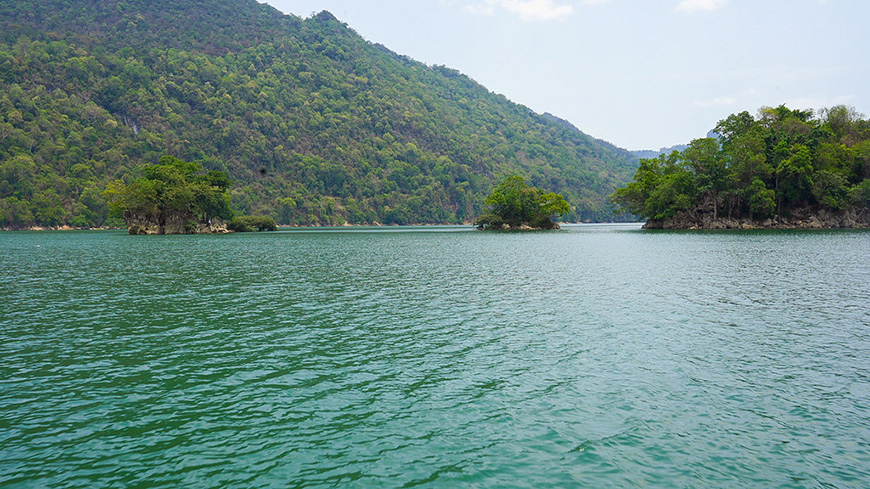 Ba Be lake - Sony A7R III
Ba Be lake - Sony A7R IIIDay 9: The serenity of Ba Be and the return to Hanoi
The last morning at Ba Be Jungle Houses was just perfect. Breakfast on the terrace, facing the lake gently waking up, it's the kind of moment where you want to pause and never leave. Léa found this atmosphere so soothing.
We walked a bit through the
rice paddies and
Bo Lu village to reach the boat. And there, it was our last aquatic adventure: three hours on
Ba Be Lake! The boat glided in silence; it was so peaceful. Léa even suggested jumping in to cool off; the waters were so calm and tempting. I contented myself with enjoying the serenity of the lake for a final meditative sketch. The boat took us along the river, and we looked up at those karst formations we now knew so well. But the craziest thing was
Puong Cave! The river passes underneath, and there are thousands of bats. Léa was a bit intimidated at first, but it was a truly fascinating, somewhat mysterious spectacle. Without really understanding why, I was struck by this striking natural phenomenon, a challenge for my sketches to render this dark and vibrant atmosphere.
Then, we returned to Bo Lu and headed for Hanoi. It was an opportunity to relax and reflect on everything we had experienced. Léa found it to be a real breath of fresh air for both of us. We arrived in the late afternoon, and even though the chaos of Hanoi enveloped us again, we are no longer the same.
This trip left its mark on us, leaving us with imperishable memories and an irrepressible desire to embark on another adventure. We returned transformed, enriched by these landscapes, these encounters, and this deep immersion. This journal will be the testament to this journey, a mix of photos, sketches, and our shared impressions.
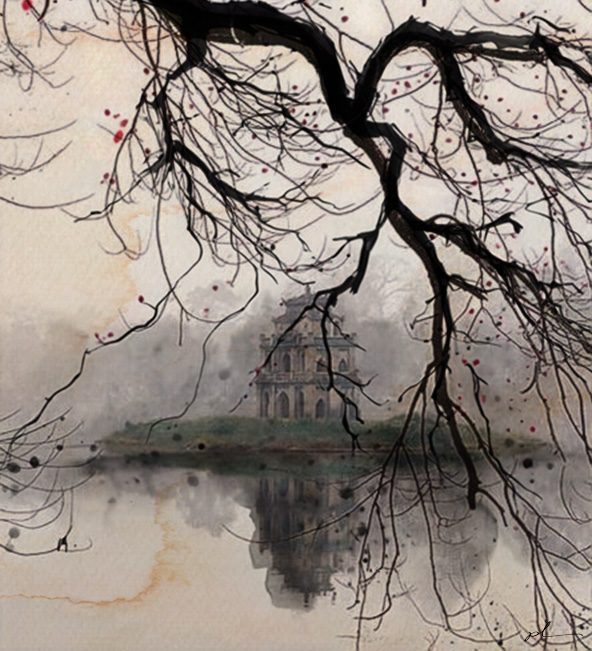 Hoan Kiem Lake, Hanoi - Mixed media on Arches ragpaper
Hoan Kiem Lake, Hanoi - Mixed media on Arches ragpaper